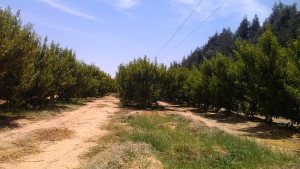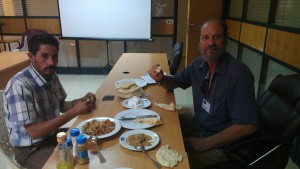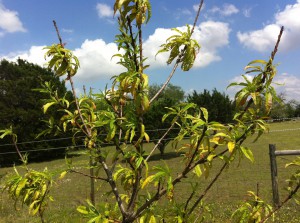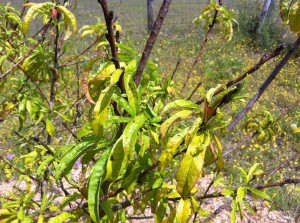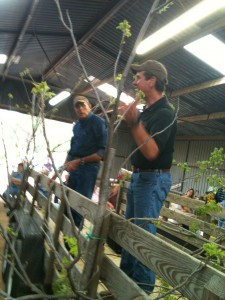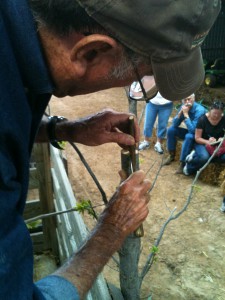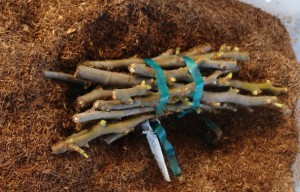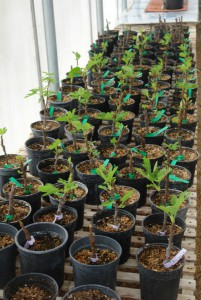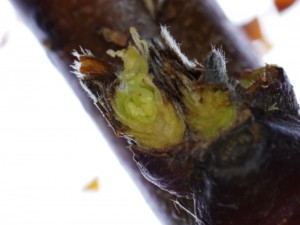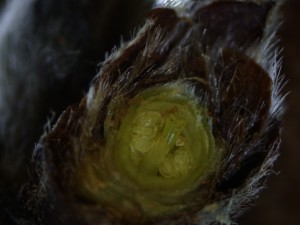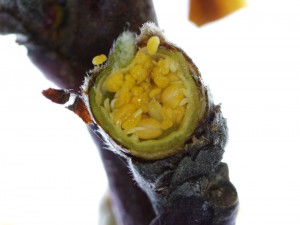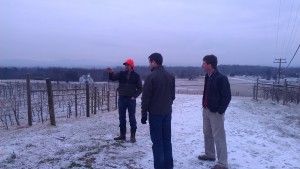Well, the cool spells that are coming in have helped hold trees and vines back a little, but every crop we work with is showing signs of life. Grapevines have wooly buds, blackberries are forcing, peaches are pushing, one more extended warm spell will mean bloom and budburst in everything. Even pears, normally one of our later blooming crops is showing signs of life. Last week on a windy, cloudy day, I spent a few hours pruning in our pear block in Fredericksburg. We have fourteen European hybrid and Asian hybrid varieties, all with quality superior to that of ‘Kieffer’ and ‘Orient’, that we have been growing without insecticide or fungicide input. So far at least, fire blight, while present, has not been a serious problem to our block. We planted Pyrus betulifolia whips in the winter of 2009 and budded them that spring. Here is a picture of the trees in the spring of 2011.
So with pears starting to force, it was a pleasure for me to take an afternoon away from the computer and the phone and get these trees pruned and trained. We have been using an array of tricks to break the strong apical dominance of many of the European hybrid varieties, some with success and a few setbacks. At first, we tried an old trick taught to me by Ron Perry who taught Hort 319 and 401 at A&M in the late 70’s. Ron asked his wife for some ruined pantyhose, cut them into lengths and tied them around the base of the tree. From there he tied erect pear limbs down with bailing twine- one end on the limb and the twine secured to the hose on the trunk. This allowed for the trunk to grow and not (theoretically) get girdled by the hose. In our case, maybe it was the cheap hose we bought at Dollar General and maybe it was how vigorously the pear trees grew, but we did have some girdling. With high winds, there was some tree breakage. Luckily, most broke above the graft union, so we had scion re-growth. Pain to deal with, but at least we didn’t lose the trees.
We have since gone to limited pruning and the use of limb weights to train pears. The problem, is that with numerous strong erect shoots competing for dominance in the pear trees, if you prune most of them off, the invigorating action of dormant pruning means that you have twice as many dominant shoots the following year. The trick is to break apical dominance without the invigoration of pruning. Here is one of our ‘Ayres’ trees going into its fifth growing season. Trees have made substantial growth in the past two years
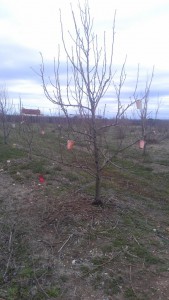
By breaking apical dominance, lateral growth is initiated and with adequate sunlight exposure, these laterals turn into fruiting spurs. Spurs are perennial fruiting structures and spur development puts these pear trees into a bearing mode rather than a vegetative mode. Some varieties, like ‘Warren’ are not at all precocious… some take ten years for first crop if left to their own devices. Triggering early spur development helps get them into production faster.

Pears are strong terminal bearers, so developing lateral growth means more flowers and more fruit. Now that the trees are larger, we use nominal pruning to remove the limbs growing back in to the interior of the tree and limb weights to increase the angle of scaffolds limbs and help develop more fruiting spurs. The weights consist of 20 oz Dixie cups with 12 guage tw wire formed into a hook, filled with concrete. After three years the cups are falling apart, but the weights are still in good shape.


These tricks worked last year and we had a great bloom and fruit set. Unfortunately, on May 7th, we had thirty minutes of golf ball sized hail that beat the crud out of everything. Figs were almost completely defoliated and it ruined our crop on pomegranates, pears and most of the vineyard. Here you can see some pretty nasty wounds caused by the hail, but fortunately, the trees are in good health and the wounds have healed over remarkably well.


